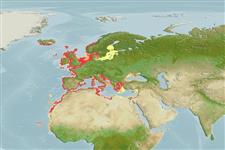Environment: milieu / climate zone / depth range / distribution range
Ecologie
marien; zoet water; brak water demersaal; katadroom (Ref. 46888); diepte 2 - 15 m (Ref. 130217). Subtropical; 65°N - 12°N, 24°W - 36°E
Eastern Atlantic: Scandinavia and Iceland (Ref. 4537) south to Senegal and Cape Verde. Also Mediterranean Sea; southwestern Black Sea (Ref. 2058).
Lengte bij maturiteit / Grootte / Gewicht / Leeftijd
Maturity: Lm 29.5 range ? - ? cm
Max length : 75.0 cm SL mannelijk / geslacht onbekend; (Ref. 35388); common length : 32.0 cm SL mannelijk / geslacht onbekend; (Ref. 7399); max. gepubliceerd gewicht: 4.5 kg (Ref. 35388); max. gerapporteerde leeftijd: 25 Jaren (Ref. 35388)
Dorsale stekels (totaal) : 5; Dorsale zachte stralen (totaal) : 7 - 9; Anale stekels: 3; Anale zachte stralen: 8 - 9.
Adults are found inshore in schools, frequently entering brackish lagoons and freshwater (Ref. 30578). They migrate occasionally tending to move northward in summer-time as temperatures rise. Females are larger than males (Ref. 59043). Adults feed mainly on benthic diatoms, epiphytic algae, small invertebrates and detritus (Ref. 2804), juveniles only feed on zooplankton (Ref. 59043). Oviparous (Ref. 205). Reproduction occurs in the sea during winter (Ref. 30578). Eggs and larvae pelagic. Utilized as a food fish (Ref. 4645).
Juveniles around 2.0 cm SL move to coastal lagoons and estuaries in April-June and return to sea in summer (Ref. 59043).
Thomson, J.M., 1986. Mugilidae. p. 344-349. In J. Daget, J.-P. Gosse and D.F.E. Thys van den Audenaerde (eds.) Check-list of the freshwater fishes of Africa (CLOFFA). ISNB, Brussels, MRAC; Tervuren; and ORSTOM, Paris. Vol. 2. (Ref. 3573)
Status op de Rode Lijst van het IUCN (Ref. 130435)
Gevaar voor de mens
Harmless
Gebruik door de mens
Visserij: commercieel; sportvis: ja; Aquarium: Publieke aquaria
Tools
Speciale rapporten
Download XML
Internetbronnen
Estimates based on models
Preferred temperature (Ref.
123201): 8.8 - 20.1, mean 11 °C (based on 420 cells).
Fylogenetische diversiteitsindex (Ref.
82804): PD
50 = 0.5005 [Uniqueness, from 0.5 = low to 2.0 = high].
Bayesian length-weight: a=0.00724 (0.00559 - 0.00939), b=3.11 (3.03 - 3.19), in cm total length, based on LWR estimates for this species (Ref.
93245).
Trofisch niveau (Ref.
69278): 2.6 ±0.32 se; based on food items.
Weerstandsvermogen (Ref.
120179): Gemiddeld, minimale populatieverdubbelingstijd 1,4-4,4 jaar (K=0.12-0.17; tm=3; tmax=25).
Fishing Vulnerability (Ref.
59153): High vulnerability (63 of 100).
Climate Vulnerability (Ref.
125649): Moderate to high vulnerability (51 of 100).
Nutrients (Ref.
124155): Calcium = 39.2 [10.7, 335.3] mg/100g; Iron = 0.623 [0.303, 1.151] mg/100g; Protein = 17.9 [16.5, 19.5] %; Omega3 = 0.399 [0.166, 0.964] g/100g; Selenium = 9.58 [3.60, 24.88] μg/100g; VitaminA = 7.52 [2.12, 24.93] μg/100g; Zinc = 0.571 [0.342, 0.951] mg/100g (wet weight); based on
nutrient studies.
